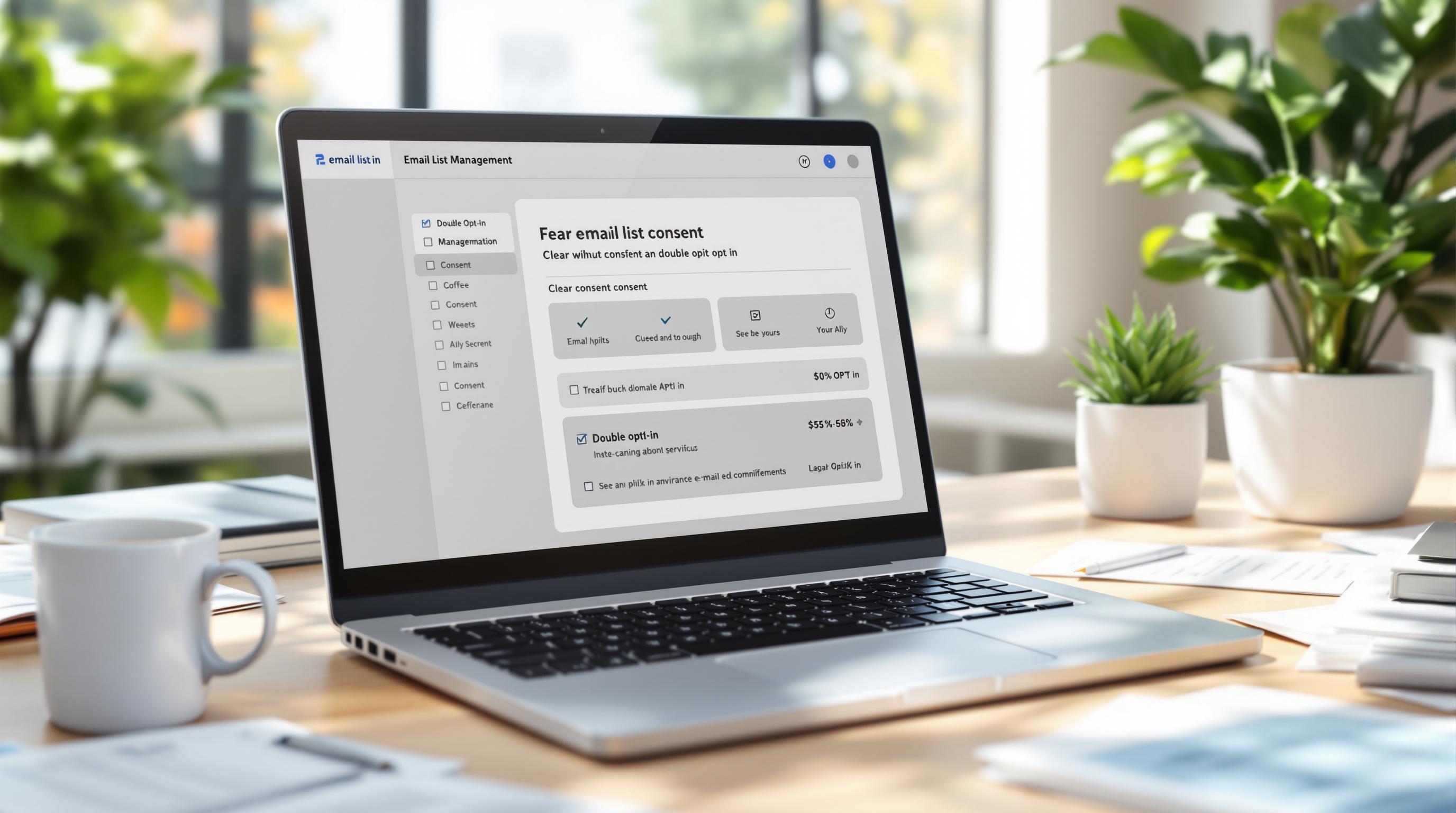Want better marketing campaigns with AI? Start by identifying your goals, evaluating tool features, and ensuring seamless integration with your systems. Here's a quick guide:
- Set clear goals: Use SMART goals to define what you want (e.g., 20% more leads in 3 months).
- Check features: Look for data analytics, predictive modeling, and automation tools.
- Ensure multi-channel support: Verify compatibility with platforms like email, social media, and CRM tools.
- Focus on user experience: A simple interface and team collaboration features are essential.
- Prioritize security: Tools must meet data protection standards like GDPR and CCPA.
Step 1: Identify Your Campaign Mapping Needs
To create an effective campaign map, start by understanding your organization's specific requirements. This will help bridge the gap between adopting AI tools and achieving success.
Set Campaign Goals
Define clear goals that align with your business objectives. Use SMART goals (Specific, Measurable, Achievable, Relevant, Time-bound) to ensure clarity and focus. For example:
- Lead Generation: Grow qualified leads by 20% within three months.
- Customer Retention: Lower churn rates by 15% over six months.
- Brand Awareness: Increase social media engagement by 30% every month.
Assess Data and Integration Needs
Identify key data sources like customer behavior patterns, transaction history, and social media activity to gain actionable insights. Data quality is often a hurdle - about 80% of companies report challenges in maintaining reliable data [1].
Ensure your tools can integrate seamlessly with your existing marketing technology stack, such as CRM systems, marketing automation platforms, and analytics tools.
Evaluate Team Skills and Budget
Take a close look at your team's technical skills and available resources. Consider whether additional training is needed and how much time implementation will require. Budget planning should account for costs like setup, training, ongoing maintenance, technical support, and potential system upgrades.
Once you’ve outlined your needs, the next step is to explore AI tools that align with your goals and requirements.
Step 2: Check AI Tool Features
Once you've outlined your campaign mapping needs, it's time to dive into the specific features of different AI tools. This step is key to ensuring you pick the right tool for your goals.
Review Data Processing and Insights
AI tools should offer strong data processing capabilities and deliver insights that help you make informed decisions. Look for features that support advanced analytics, real-time tracking, and customizable reporting to meet your campaign requirements.
Here are some important features to consider:
- Advanced Analytics: Handles large datasets to uncover useful patterns.
- Real-time Monitoring: Keeps tabs on campaign performance as it happens.
- Custom Reporting: Provides reports tailored to your specific goals.
Check Predictive Modeling
Predictive modeling can be a game-changer. It helps you understand customer behavior, spot trends, and make better decisions for targeting and campaign adjustments.
| Feature | Purpose | Benefit |
|---|---|---|
| Behavior Analysis | Understand and predict customer actions | Enhances targeting precision |
| Trend Detection | Spot new patterns in the data | Allows for timely adjustments |
| Performance Forecasting | Estimate campaign results | Improves resource planning |
Assess Automation and Workflow
"The ROI you can glean from AI marketing tools essentially comes down to two things: Automation, which allows you to complete tasks faster, and Data - or, more specifically, the ability to gather and group large amounts of it, extract value from it, and then act effectively on insights through constant learning."
When analyzing automation features, focus on these areas:
- Integration Capabilities: The ability to connect smoothly with your current marketing tools.
- Workflow Customization: Flexibility to fit into your team's processes.
- Task Automation: Streamlines repetitive tasks, saving time and boosting efficiency.
These features are essential for effective campaign mapping. They empower marketers to make smarter, data-driven decisions and enhance overall campaign performance. Once you've reviewed the tool's features, ensure it supports all your marketing channels for easy multi-channel execution.
Step 3: Verify Multi-Channel Support
Using multiple marketing channels can lead to a 24% boost in conversion rates compared to sticking to just one channel [3]. Why? It ensures your messaging stays consistent and keeps your audience engaged across different platforms.
Check Channel Compatibility
Make sure the platform works well with your existing marketing tools. Here's what to look for:
| Integration Type | Purpose | Key Consideration |
|---|---|---|
| Pre-built Connectors | Quick setup with popular platforms | Fits seamlessly with your current tools |
| API Support | Custom integration options | Handles formats like CSV with ease |
| Real-time Sync | Instant data updates | Performs well across all chosen channels |
Tools like Marketo and Pardot excel in this area, offering robust integration options to keep your data aligned across platforms [2].
Once you've confirmed compatibility, focus on making your messaging as impactful as possible through personalization.
Evaluate Personalized Messaging
Platforms like Adobe Campaign show how personalization can be done right. They allow marketers to craft tailored email campaigns based on customer behavior while ensuring the same tone and message carry over to social media [2].
What makes personalization effective?
- Automatically adapting content to match user behavior and preferences
- Grouping audiences for targeted messaging across channels
- Testing and refining your messaging to see what works best
When evaluating tools, check for these features:
- Consistent messaging tailored for each platform
- Tools to monitor engagement and scale campaigns
- Metrics to measure how well personalization works across different audience segments
With multi-channel support and personalized messaging sorted, the next step is making sure the platform integrates smoothly with your team and existing systems.
sbb-itb-8abf799
Step 4: Assess User Experience and Integration
To make sure your AI tool effectively supports your campaign mapping, it's important to evaluate how well it fits into your team's workflow and existing systems.
Review User Interface
A user-friendly interface makes your team's work easier and speeds up setup time. Tools with features like drag-and-drop functionality can save a lot of time.
Here are some key interface elements to look at:
| Feature | Purpose | Impact on Workflow |
|---|---|---|
| Visual Campaign Builder | Drag-and-drop functionality | Speeds up campaign setup |
| Dashboard Organization | Clear metrics visualization | Helps with quick decision-making |
| Navigation Structure | Intuitive menu layout | Reduces the learning curve for users |
Even with a great interface, the tool must integrate well with your current systems. That’s the next step to consider.
Check Martech Stack Integration
Your AI tool needs to work seamlessly with your existing marketing tools to ensure smooth campaign mapping. For example, platforms like Kajabi offer strong integration capabilities [4].
Key integration factors to explore:
- API Flexibility: Check if the tool supports custom integrations through robust APIs.
- Native Connectors: Look for pre-built integrations with popular marketing platforms.
- Data Synchronization: Confirm that data flows in real-time between the tool and your systems.
But integration isn’t just about technology - collaboration features are equally important for team efficiency.
Evaluate Team Collaboration
Strong collaboration features can simplify communication and streamline approval processes for campaigns.
Here are some collaboration features to assess:
| Feature | Benefit | Implementation Example |
|---|---|---|
| Real-time Editing | Allows teams to work together | Multiple team members can edit content at once |
| Approval Workflows | Organizes the review process | Customizable approval chains for campaigns |
| Asset Management | Centralizes campaign resources | Shared libraries for storing campaign materials |
Step 5: Ensure Data Security and Compliance
In 2022, 64% of organizations experienced data breaches [3]. This makes securing your data a top priority when choosing AI tools for campaign mapping.
Check Data Protection and Compliance
The AI tools you select must have robust security measures to protect campaign data and meet regulatory requirements. Key features to look for include:
| Security Feature | Purpose | Implementation |
|---|---|---|
| Data Encryption | Safeguards data in storage and transit | AES-256 encryption standard |
| Access Controls | Prevents unauthorized access | Multi-factor authentication |
| Secure Storage | Protects campaign information | Certified data centers |
Additionally, evaluate compliance with major regulations like GDPR and CCPA. This involves reviewing:
- Data Processing Agreements
- Privacy Policies
- Security Certifications (e.g., ISO 27001, SOC 2)
Keep in mind, GDPR violations can lead to fines of up to €20 million or 4% of global revenue [2].
Review Data Ownership
Understanding data ownership is just as important. Your AI provider should clearly outline:
- Who owns the data: Ensure you retain control over your campaign information.
- Retention policies: Know how long data is stored.
- Usage terms: Confirm your data won't be used for purposes you didn’t agree to.
Transparent policies give you peace of mind while enabling you to fully utilize AI tools.
Email Extractor Tool - Extract Emails with AI Automation

When evaluating AI tools for campaign mapping, finding solutions that streamline lead generation and data collection is key. The Email Extractor Tool uses AI-driven automation to integrate smoothly into multi-channel campaigns.
How It Helps with Campaign Mapping & Key Features
This tool simplifies campaign mapping by automating email extraction, allowing marketing teams to concentrate on strategy instead of manual tasks. Here's how it can make a difference:
| Campaign Element | Tool Capability | Business Impact |
|---|---|---|
| Lead Generation | AI-driven email extraction | Cuts down on manual work |
| Data Collection | Automated email detection | Boosts data accuracy |
| Multi-channel Support | Chrome extension integration | Streamlined workflows |
Some standout features include:
- AI-Powered Detection: Automatically finds and extracts valid email addresses.
- Chrome Extension: Fits seamlessly into your existing processes.
- Export Options: Download results in CSV or TXT formats.
- Automation: Reduces the need for manual input in lead generation tasks.
Pricing Plans
Flexible pricing options are available to suit different campaign requirements:
| Plan | Monthly Cost | Email Volume | Key Benefits |
|---|---|---|---|
| Starter | $8.99 | 5,000 emails | Basic automation, CSV export |
| Growth | $37.99 | 50,000 emails | Priority support, advanced tools |
| Enterprise | $139.99 | 1,000,000 emails | Premium support, high capacity |
Conclusion: Choose the Right AI Tools for Campaign Mapping
Key Points to Consider
Picking the right AI tools for campaign mapping involves a thoughtful approach. The features for data processing and predictive modeling should match your campaign goals while ensuring strong security measures and smooth integration with your existing martech setup.
| Evaluation Area | Key Considerations | Impact on Campaigns |
|---|---|---|
| Data Processing | AI-powered insights, automation features | Better decision-making accuracy |
| Integration | Compatibility with martech stack, API options | Improved workflow efficiency |
| Security | Data protection policies, compliance adherence | Reduced risks, regulatory compliance |
| Scalability | Ability to handle growth, resource efficiency | Cost-effective for long-term use |
Using these criteria as a guide, the focus should shift to implementation and maximizing long-term benefits.
Practical Tips for Selecting AI Tools
When choosing an AI tool, focus on solutions that deliver clear automation advantages. For instance, tools that simplify lead generation can save time and improve overall efficiency.
Look for tools that provide actionable insights, ensure strong data security, integrate seamlessly with your systems, and can scale to meet future demands. It's also essential that the tool supports consistent communication and engagement across all marketing platforms.
Ultimately, success lies in selecting tools that align with your campaign goals today and can adapt to future strategies.



